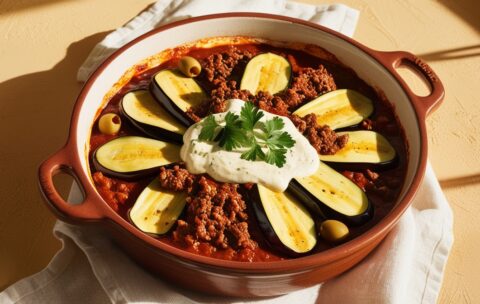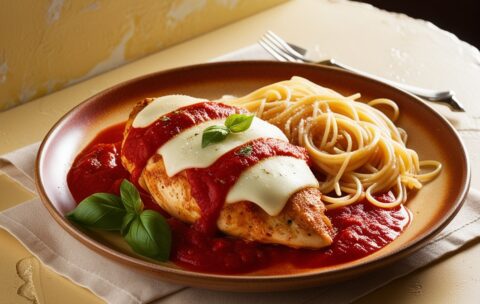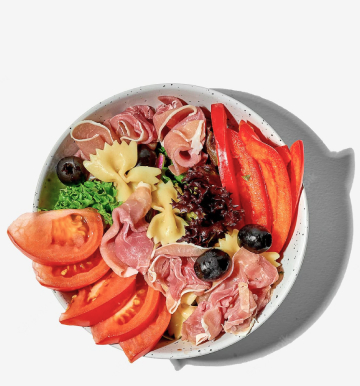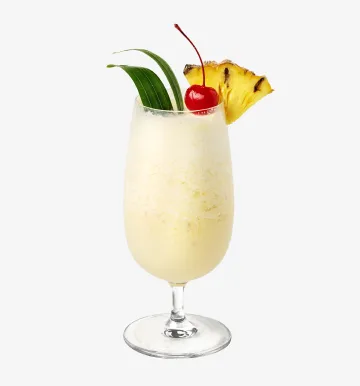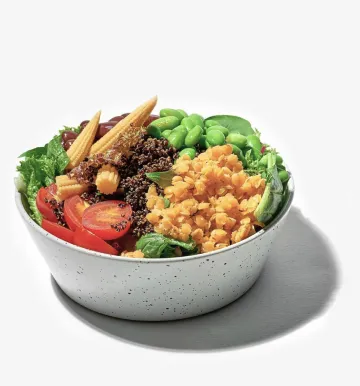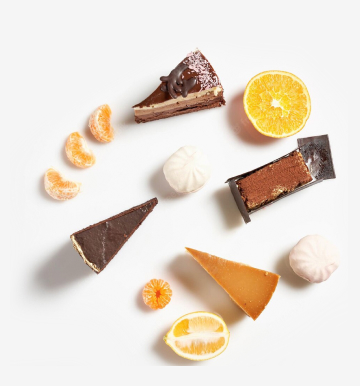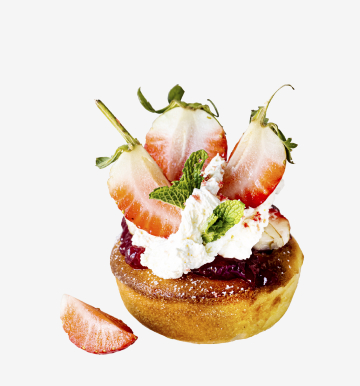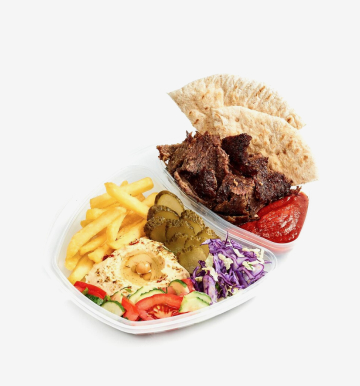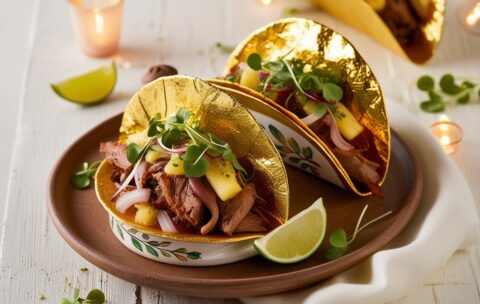Home Update 02
October 4, 2023 2025-06-05 13:04Home Update 02
Become a Home Chef
Learn to cook from scratch and master restaurant-quality meals in your own kitchen. Perfect for beginners and food lovers.

Our Top Courses
We've selected the best programs to get you started. Each course offers step-by-step lessons, hands-on recipes, and guaranteed results — even for beginners.
Moussaka
3 Lessons
1.1 hour
Intermediate
What you'll learn
How to choose and prepare eggplants (salting/removing bitterness, proper slicing, and roasting) for ideal texture.
Techniques for browning ground lamb or beef, layering in tomato paste, crushed tomatoes, and seasonings (cinnamon, oregano, allspice).
Steps to make a silky-smooth béchamel sauce: roux creation, milk tempering, seasoning, and controlling thickness.
Methods for constructing Moussaka “assembly”—layering eggplant, meat sauce, and béchamel—to ensure even baking.
Guidelines for baking time and temperature so the top turns golden brown without drying out the filling.
Presentation tips: letting Moussaka rest for clean slices, garnishing with chopped parsley, and pairing with Greek salad or crusty bread.
Salmon Confit on Baby Spinach
4 Lessons
1.4 hour
Intermediate
What you'll learn
How to choose high-quality salmon for confit (fresh-fish selection, portion sizes)
Steps to prepare the poaching oil with aromatics (garlic, thyme, citrus)
Technique for gently poaching salmon at a precise low temperature (175–185 °F / 80–85 °C)
Preparing baby spinach with a light lemon-mustard vinaigrette (emulsion basics)
Methods for plating so the salmon and spinach complement each other visually and texturally
Art of Fondant & Modeling Chocolate
4 Lessons
1.2 hour
Intermediate
What you'll learn
Fondant Fundamentals: How to knead, roll, and cover a cake in smooth fondant; troubleshooting common issues like tearing or cracking.
Color Mixing & Painting: Methods for achieving uniform pastel or vibrant hues using gel, powder, and airbrush techniques; blending shades for gradients and ombré effects.
Modeling Chocolate Preparation: Step-by-step process to make stable, pliable modeling chocolate at home—adjusting ratios for firmness or flexibility.
Sculpting Techniques: Building 3D elements (flowers, animals, figurines) layer by layer; using armature supports for larger models.
Texture & Embellishment: Creating realistic surface details—wood grain, lace patterns, ruffles, and draping—using molds, veiners, embossing tools, and impression mats.
Piping & Detailing: Accenting fondant and modeling chocolate pieces with royal icing, edible beads, and dusting powders to add dimension and realism.
Assembly & Structural Integrity: Best practices for attaching heavy sugar components to cake tiers; internal support systems (dowels, skewers) to ensure stability during transport and display.
Niçoise Salad
3 Lessons
3.5 hours
Intermediate
What you'll learn
How to cook baby potatoes to a tender yet firm “bite”
Blanching haricot verts (thin green beans) for vibrant color and snap
Properly searing fresh tuna (or preparing high-quality canned tuna)
Crafting a classic Dijon-vinaigrette with shallots and garlic
Composing and plating a balanced, restaurant-style Niçoise
Cosmopolitan
6 Lessons
5.2 hours
Intermediate
What you'll learn
How to select and measure high-quality vodka, cranberry juice, Triple Sec (or Cointreau), and fresh lime juice for optimal balance.
Proper shaking technique: ice selection, shaker fill level, and timing to achieve a silky-smooth texture and bright color.
Glassware choice and chilling methods (using a martini glass vs. a coupe).
Classic garnish options—lime wheel or twist—and how to express citrus oils for aroma.
Variations on the original recipe (e.g., swapping orange liqueurs or adjusting tartness).
Tips for batch-make a pitcher of Cosmopolitans without losing the vibrant hue and balanced taste.
Eggplant Parmesan
4 Lessons
59 minutes
Intermediate
What you'll learn
Below is an overview of the key skills and concepts you’ll master by the end of this lesson.
Outcome Description
Eggplant Selection & Prep Identify firm, glossy eggplants with minimal seeds; learn to salt and remove bitterness.
Breaded Coating Technique Achieve a crisp, golden crust using both breadcrumb and flour methods.
Tomato Sauce Creation Make a balanced marinara: tomato acidity, sautéed aromatics, and fresh basil notes.
Layering & Baking Stack components without sliding, ensuring even coverage and melt.
Cheese Choices & Melting Compare mozzarella versus provolone, and understand how Parmigiano-Reggiano adds depth.
Presentation & Garnish Plate the dish with fresh herbs, extra cheese shavings, and optional balsamic glaze.
Chicken Parmesan
2 Lessons
1.8 hour
Intermediate
What you'll learn
Outcome Description
Selecting & Preparing Chicken Choose ideal cuts (boneless, skinless breasts or tenderloins), pound to even thickness, and properly season.
Three-Stage Breading Technique Execute a flour-dredge, egg wash, and breadcrumb coating (panko or Italian-style) for consistent crispness.
Marinara Sauce Essentials Create a balanced tomato sauce with sautéed aromatics, herbs, and proper simmering techniques for depth.
Cheese Layering & Melting Understand how to layer mozzarella and Parmigiano-Reggiano for optimal melt, flavor, and browning.
Baking & Broiling Methods Bake cutlets at the correct temperature, then broil to achieve a bubbly, golden cheese crust without overcooking chicken.
Serving & Garnishing Present the dish with complementary sides (pasta, salad), fresh basil, and extra cheese shavings.
Foie Gras–Topped Mini Slider
3 Lessons
1.3 hour
Intermediate
What you'll learn
Patty Composition: Balancing fat ratio and seasoning for ultra-tender mini burgers
Brioche Bun Technique: Butter-basting and gentle toasting for optimal texture
Foie Gras Preparation: Searing foie gras medallions to achieve a crisp exterior and silky interior
Gastrique Creation: Red wine-and-shallot reduction with a touch of vinegar for sweet-tart balance
Assembly & Presentation: Layering components for structural integrity and visual allure
Flavor Pairings: Complementary garnishes such as microgreens, fleur de sel, and truffle oil
Paella Valenciana
2 Lessons
3.3 hours
Intermediate
What you'll learn
History and Regional Context
Origins of Paella Valenciana and its connections to Valencian agricultural traditions.
Distinctions between classic Valencian paella, seafood paella (Paella de Mariscos), and other regional variants.
Selecting and Preparing Ingredients
Rice varieties (Bomba vs. Calasparra) and their impact on texture.
Choosing quality proteins (chicken and/or rabbit), native beans (judía verde, garrafó), olive oil, and saffron threads.
Preparing vegetables: green beans (bajoqueta), garrafó beans, fresh tomatoes, and garlic.
Cooking Techniques and Timing
Building a sofrito base: sautéing meat, vegetables, and spices to develop depth of flavor.
Proper rice-to-liquid ratio and how to incorporate stock infused with saffron.
Achieving the prized socarrat (crispy rice crust) without burning.
Adjusting heat levels for even cooking and optimal moisture absorption.
Presentation and Serving
Traditional ways to serve Paella Valenciana—family style straight from the paellera.
Garnishing options (lemon wedges, fresh parsley) to enhance aroma and appearance.
Tips for reheating and storing leftovers without compromising texture.
Honey Cake
6 Lessons
3.9 hours
Intermediate
What you'll learn
Ingredient Harmony
How honey interacts with flour, eggs, and spices for moist crumb.
Balancing baking soda and acidic components to ensure proper rise.
Mixing & Resting
Techniques for creaming butter, sugar, and honey without overmixing.
Importance of resting batter to develop flavor.
Baking & Texture Checks
Identifying doneness via toothpick test vs. spring-back method.
Preventing dryness through temperature control and timing.
Presentation & Serving
Simple glazing ideas and dusting techniques.
Pairing suggestions (e.g., whipped cream, fresh berries).
Choose Your Category
Our courses are grouped by category to help you find what suits your taste. From quick dinners to gourmet desserts — start with what inspires you.



About Our Culinary Journey
We are passionate about bringing the joy of cooking to everyone. Our mission is to empower food lovers with the skills and confidence to create delicious meals at home. With expert chefs, innovative teaching methods, and a love for culinary arts, we’re here to inspire your kitchen adventures.
Our Commitment
Everyone can cook well. Our courses offer clear guidance to ensure success for all skill levels.
Community Focus
Join our foodie community. Share creations and grow in a supportive environment.
Why Choose Our Culinary Courses?
Our courses are designed to make cooking fun, accessible, and inspiring. Whether you're a beginner or a seasoned cook, our unique features will help you elevate your skills and unleash your culinary creativity.

Expert Instructors
Learn from world-class chefs with years of experience. Our instructors guide you step-by-step, sharing professional tips.

Flexible Learning
Study at your own pace, anytime, anywhere. Our online platform offers 24/7 access to lessons, so you can fit cooking into your busy schedule.

Hands-On Recipes
Practice with real recipes designed for all skill levels. From classic dishes to modern creations, you’ll master meals that impress every time.
What Our
Students Say
Hear from our happy students who have transformed their cooking skills with our courses. From beginners to seasoned cooks, our community loves sharing their success stories!
"This course completely changed how I cook! The instructors are so knowledgeable, and the lessons are easy to follow. I’m now confident making dishes I never thought I could."
Emma Johnson
"I love the flexibility of these courses. I can learn at my own pace and still feel supported. The recipes are amazing, and I’ve impressed my family with new dishes!"
Michael Chen
"The vegan cooking course was a game-changer for me. I learned so many creative ways to make plant-based meals that taste incredible. Highly recommend!"
Sophie Martinez
"The hands-on approach made learning so fun! I went from burning toast to baking artisan bread in weeks. Thank you for such an inspiring experience!"
James Carter
Discover Our Newest Culinary Courses
Get inspired by our latest additions! These exciting courses bring fresh ideas and techniques to your kitchen, perfect for food lovers eager to try something new. Browse our carousel to find your next culinary adventure.
International Cake Traditions
5 Lessons
2.9 hours
Intermediate
What you'll learn
How to prepare and bake at least five signature cakes from different countries, using authentic ingredients and methods
The cultural and historical significance of each cake: when and why it’s traditionally served
Variations on flavorings and decorations that make each region’s version unique
Techniques for achieving proper texture, moisture, and flavor balance in international recipes
Tips for adapting ingredients when certain items are not readily available in your area
Presentation ideas to honor traditional styles (for example, Panettone’s distinctive domed shape or a Japanese wagashi’s intricate design)
Layer Cake Construction & Filling Strategies
3 Lessons
58 minutes
Intermediate
What you'll learn
Baking for Uniform Layers: How to prep pans (lining, spray), adjust batter distribution, and use baking strips or temperature hacks for flat, even cake tops.
Leveling & Stacking: Knife vs. cake leveler methods; applying a thin “crumb coat” of frosting; inserting dowels or straws for multi-tier support; stacking layers without slippage.
Filling Varieties & Textures: Selecting between custards, curds, fruit compotes, ganaches, buttercreams, and mousse fillings—considering sweetness, moisture control, and pairings (e.g., raspberry curd with chocolate cake).
Preventing Leaks & Weeping: Techniques for sealing cake layers (buttercream dam, chocolate collar), ensuring fillings stay contained; chilling strategies to set fillings before final coating.
Flavor Harmony & Balance: Matching cake flavor (vanilla, chocolate, spice) with filling profiles (tart, sweet, creamy) to avoid one element overpowering another; adjusting sweetness levels.
Finishing & Presentation Prep: Applying a smooth final coat of frosting or ganache; creating optional decorative borders or piped accents; slicing tips for clean, even servings.
Paella Valenciana
2 Lessons
3.3 hours
Intermediate
What you'll learn
History and Regional Context
Origins of Paella Valenciana and its connections to Valencian agricultural traditions.
Distinctions between classic Valencian paella, seafood paella (Paella de Mariscos), and other regional variants.
Selecting and Preparing Ingredients
Rice varieties (Bomba vs. Calasparra) and their impact on texture.
Choosing quality proteins (chicken and/or rabbit), native beans (judía verde, garrafó), olive oil, and saffron threads.
Preparing vegetables: green beans (bajoqueta), garrafó beans, fresh tomatoes, and garlic.
Cooking Techniques and Timing
Building a sofrito base: sautéing meat, vegetables, and spices to develop depth of flavor.
Proper rice-to-liquid ratio and how to incorporate stock infused with saffron.
Achieving the prized socarrat (crispy rice crust) without burning.
Adjusting heat levels for even cooking and optimal moisture absorption.
Presentation and Serving
Traditional ways to serve Paella Valenciana—family style straight from the paellera.
Garnishing options (lemon wedges, fresh parsley) to enhance aroma and appearance.
Tips for reheating and storing leftovers without compromising texture.
Tiramisu
4 Lessons
2.5 hours
Intermediate
What you'll learn
Espresso Preparation & Soaking Technique (Paragraph + List):
You will master brewing strong espresso (or concentrated coffee) and learn how to quickly dip ladyfingers to prevent soggy layers.
Selecting grind size and brew method for intense flavor
Timing the dipping process: just enough to infuse coffee without collapsing the biscuit
Balancing sugar in coffee liquid to sweeten subtly
**Mascarpone Cream Assembly (Table):
Step Key Tip
Whipping Egg Yolks & Sugar Whisk until pale ribbon stage for stability
Folding Mascarpone & Cream Use gentle motions to maintain airiness
Flavor Infusion Add a shot of coffee liqueur or vanilla
This table highlights how each stage contributes to a smooth, stable cream.
Layering & Chilling (Paragraph):
Learn to create uniform layers—alternating soaked ladyfingers and mascarpone cream—then chill for at least 4–6 hours (or overnight) to allow flavors to meld and set properly. Presentation tips include smoothing the top layer and evenly dusting cocoa powder.
Variations & Garnishes (Bullet List):
Fruit Twist: Add a layer of fresh berries or fruit compote between cream layers.
Chocolate Shavings: Sprinkle dark chocolate curls on top for visual contrast.
Alcohol Options: Use Marsala, rum, or coffee liqueur to deepen flavor.
Caramelized Banana
2 Lessons
2.4 hours
Intermediate
What you'll learn
Banana Selection & Ripeness
How to choose bananas at the peak of sweetness and proper firmness for caramelizing.
Recognizing visual and tactile cues that indicate ideal ripeness.
Caramel Sauce Preparation
Techniques for melting and browning sugar without burning—achieving a smooth, amber-hued caramel.
Balancing sweetness and depth by adjusting cook time and adding flavor enhancers like vanilla or citrus.
Cooking & Coating Bananas
Proper slicing methods to ensure even cooking.
Timing the addition of butter and bananas so the fruit softens without turning mushy.
Tips for gently tossing banana slices in hot caramel to create uniform coating.
Serving & Pairing Ideas
Creative ways to plate caramelized bananas as a standalone dessert or as a component (pancakes, waffles, yogurt, ice cream).
Garnish suggestions—nuts, herbs, spice dustings—to add texture and color contrast.
Storage and make-ahead strategies to preserve caramel’s texture and banana integrity.
Daiquiri
3 Lessons
59 minutes
Intermediate
What you'll learn
The origin and evolution of the Daiquiri, from early 20th-century Cuba to modern bars.
How to select and measure white rum, lime juice, and simple syrup for optimal balance.
Proper shaking technique: ice selection, shaker fill level, and pour timing.
Glassware choice and presentation tips (e.g., chilled coupe vs. Nick & Nora glass).
Simple variations (e.g., adding fruit purée or flavored syrups) while preserving the classic profile.
Gold-Leaf Tacos al Pastor
5 Lessons
1.9 hour
Intermediate
What you'll learn
Achiote Marinade Mastery: Craft the traditional adobo marinade using achiote paste, pineapple juice, garlic, and spices.
Marination & Stacking Techniques: Properly marinate and assemble the pork “trompo” for optimal flavor infusion.
Homemade Tortillas: Mix, press, and cook fresh corn tortillas to serve as the perfect base.
Grill & Carve: Safely grill the marinated pork and learn slicing techniques for perfectly tender pieces.
Edible Gold Application: Handle and apply edible gold leaf to enhance both taste and presentation.
Plating & Garnishing: Combine classic toppings—pineapple, onion, cilantro—with gold accents for a balanced, eye-catching dish.
Vegetable Tart with Roasted Pepper and Goat Cheese
2 Lessons
2.2 hours
Intermediate
What you'll learn
How to roast bell peppers to achieve tender flesh and smoky flavor (peeling and deseeding techniques)
Techniques for caramelizing onions to bring out natural sweetness without burning
Preparing a Dijon crème fraîche base for balanced creaminess and tang
Layering vegetables and cheese to ensure even baking and flavor distribution
Baking tips to achieve a uniformly golden, flaky tart shell and prevent soggy bottom
Mini Crab Cakes with Lemon Aioli
5 Lessons
58 minutes
Intermediate
What you'll learn
How to select and handle fresh lump crab meat for maximum flavor and minimal shell fragments.
The proper ratio of binders (egg, mayonnaise, breadcrumbs) to create tender, non-gummy crab cakes.
Techniques for shaping consistently sized mini patties that hold together during cooking.
Pan-frying tips to achieve a uniformly golden, crisp exterior without overcooking the interior.
How to prepare a smooth, emulsified lemon aioli with the right balance of acidity and creaminess.
Plating and serving suggestions to present mini crab cakes attractively for guests.
Shrimp Scampi
4 Lessons
59 minutes
Intermediate
What you'll learn
How to select and properly devein shrimp for optimal texture and presentation.
Techniques for building a flavorful scampi sauce: sautéing garlic, deglazing with white wine, and adjusting lemon acidity.
Timing and heat control so shrimp cook through without becoming rubbery.
Methods for emulsifying butter into the sauce for a silky finish.
Pairing suggestions: choosing the right pasta, crusty bread, or vegetable accompaniment.
Plating tips to showcase the shrimp and sauce elegantly.

